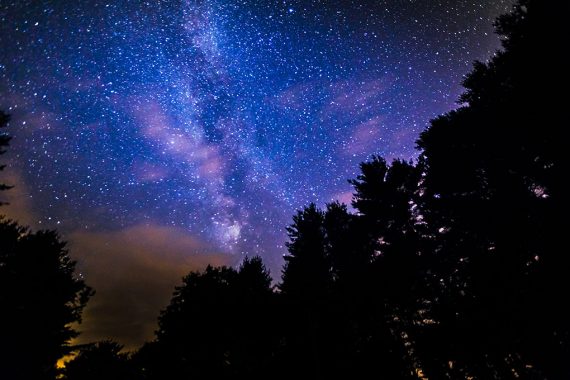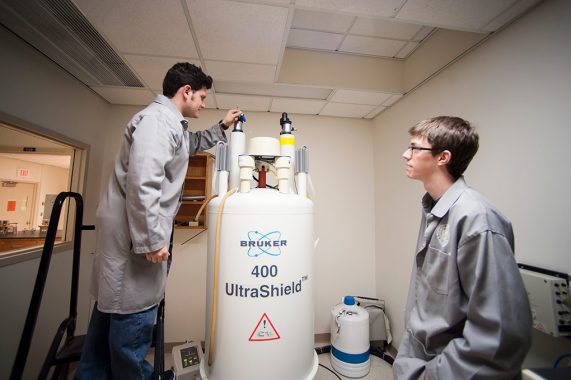Preserving art in conflict
During World War II, the Mona Lisa was moved five times to keep it safe from looters. But other works of art and cultural materials weren’t so lucky. Under the direction of Adolf Hitler, the Germans looted paintings, church bells, Torahs, and more.
Enter the Monuments Men, who were cultural-preservation officers recruited by the Allies to protect and recover art during the war. Robert Edsel, who has written three books on the subject, visited campus Oct. 19 to deliver the keynote speech for a three-day conference titled Preserving Cultural Heritage in Times of Conflict.
“As the war progressed and the degree of theft became known as countries were liberated, [the Monuments Men] quickly became art detectives trying to track down these looted works of art,” Edsel said.
The conference kicked off with a free film screening of The Monuments Men (2014), which was inspired by one of Edsel’s books and directed by George Clooney. Over the next few days, national scholars with a variety of expertise addressed critical questions regarding theft of cultural property, art, and antiquities during wartime. The Monuments Men — many of whom were museum curators, art historians, archivists, and artists themselves — served as an example of how cultural property could be saved in times
of conflict.
The problems the men and women were seeking to solve are still happening today. One current example, Edsel said, is the architecture destroyed by ISIS in Palmyra, Syria, in 2016. “This is a challenge of our times, how to go about protecting these parts of our shared cultural heritage, but we’re not without guideposts.”
Associate art and art history professor Carolyn Guile explained, “Our cultural property is being destroyed on a scale not seen since World War II.” This, she said, was part of the motivation for the event, which Guile organized with archaeologist Michael Danti, NEH associate professor of the humanities.
Throughout the weekend, visiting scholars addressed topics including moral and legal claims to cultural property, cultural heritage preservation post conflict, and the U.S. response to illicit antiquities trafficking.
“We were proud to host a conference like this here and invite some of the key figures doing the on-the-ground work — including Michael [Danti] himself, [Shawnee State University Associate Professor of History and Anthropology] Amr Al-Azm, [associate curator in charge of the Near East Section at the Penn Museum] Richard Zettler, and [Executive Director of Red Arch Cultural Heritage Law and Policy] Ricardo St. Hilaire, among others — to bring the issues and discussion to the community,” Guile said. As respondents, Colgate professors Rebecca Ammerman, Robert Garland, Padma Kaimal, Elizabeth Marlowe, Robert Kraynak, and Xan Karn stimulated further discussion following
each panel.
Conversation around the destruction and preservation of cultural heritage also has a place on campus in Guile’s Borderlands class as well as through the Global Engagements, Arts, Classics, and Russian and Eurasian Studies programs, and the programs through the Center for Freedom and Western Civilization.
Colgate’s own Monuments Man
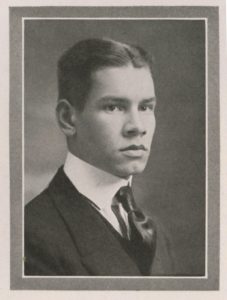
Gilbert Harry Doane, Class of 1918, played an important behind-the-scenes part in World War II. A native of Fairfield, Vt., he served as a librarian in the Monuments, Fine Arts and Archives section. Here we trace Doane’s life:
After Colgate
He became a librarian for the Genealogy Society at the U.S. Naval Training Station in Newport, R.I. Doane earned his graduate certificate from the New York State Library School in 1920. He then worked as a librarian at a few universities before ending up at the University of Wisconsin, where he was the director of libraries.
During the war
Doane trained at the School of Military Government in Charlottesville, Va., from December 1943 until January 1944. At the American School Center in Shrivenham, England — an Officers Candidate School of the European Civil Affairs Division — Doane was a librarian who managed documents and lists of protected monuments found by the Monuments Men.
Post-war
In 1945, he retired from the military and once again became the director of libraries at the University of Wisconsin. He worked as a librarian, and later
an archivist, until 1962, when he earned the title of professor emeritus.
As an author
Doane published several books about genealogy, including Searching for Your Ancestors (1937) and Collecting Bookplates (1941), in addition to a biography
of Rev. Jackson Kemper, the first Episcopal bishop of Wisconsin.
In the church
He became a deacon of the Episcopal Church in 1943 and eventually served as a priest in Wisconsin. He died in 1980.
Education through activism
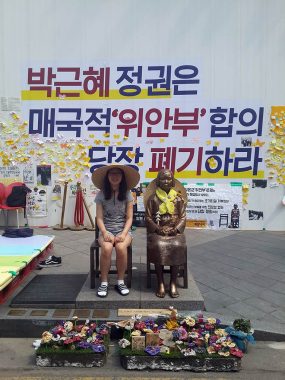
“My research isn’t detached from my activism,” said Woohee Kim ’18, an educational studies major who conducted research in Seoul, South Korea, in summer 2017.
As a Lampert Institute Fellow, Kim researched Korean education and youth activism, concluding that students create new sites of learning outside of the traditional education system when they participate in activism.
The Lampert Institute for Civic and Global Affairs integrates on-campus programming with faculty-mentored student research. In addition to the summer fellowship, the Lampert Institute offers the Summer Language Scholarship and the on-campus Lampert Associates program.
Kim became interested in the topic during her first year at Colgate, when she took the course The American School with Professor Anne Rios-Rojas and participated in the September 2014 campus sit-in organized by the Association of Critical Collegians.
“I count that as the first moment of youth activism for me,” she said. “I then began to think about my life back home in Korea, and I wanted to bridge that to the activist self I started to build here.”
The “banking” model of education in South Korea, which is focused on depositing knowledge, discourages participation in demonstrations and protests. In her paper, Kim argues that when students break out of this model and engage in activism, they transform from passive receivers to active producers of knowledge.
Kim did fieldwork for three months in Seoul, South Korea. She collected participant observations by attending protests and meetings held by activist groups, and conducted interviews with 14 Korean youth activists.
“I was immersed in my participant observations. I was climbing into sleeping bags in the street, camping out with youth activists, and shouting slogans with them,” Kim said.
She and other activists organized around a statue commemorating the thousands of Korean women who were trafficked and sexually abused by Japanese soldiers during World War II. Korean survivors erected the memorial in front of Japan’s embassy in Seoul; it is now under threat of removal, which activists are fighting to prevent.
Both researching and participating in activism made Kim think about her position as a scholar-activist. Funded by the Lampert Institute, she attended an educational studies conference in Washington, D.C., to present on her experiences with scholar-activism in South Korea.
“After doing my summer research with the Lampert, I came out with the understanding that this is what I want to do with my life,” she said. “I want to be a scholar-activist, whatever shape or form that may take.”
Kim and eight other 2017 Lampert Institute Fellows returned to Colgate after their summer research and presented their completed papers on Nov. 1.
— Emily Daniel ’18
Ethics of war
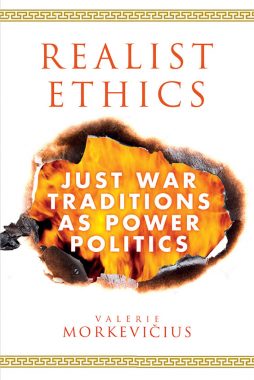
Is it ever ethical to go to war? Can war be both politically advantageous and morally just? According to Valerie Morkevicius, associate professor of political science, the answers to these questions are more complicated than a simple yes or no.
Morkevicius’s new book, Realist Ethics (Cambridge University Press), explores two schools of political philosophy — just war thinking and realism — and argues that they have more in common than both sides tend to think.
“Just war thinking is a tradition that considers whether it is ever ethically sound to use war to solve a political problem, and if so, what would be the right ways to go about fighting that war,” Morkevicius explained.
Realism is the more pragmatic counterpart to just war thinking, with some realists arguing that moral limits and moral aims should not be involved in war.
“Realists are seen as war-mongering pragmatists, and just war thinkers are seen as naïve at best and pacifistic at worst,” said Morkevicius. “Realist Ethics argues that this oversimplification is not only wrong, but dangerous.”
To show that just war thinking and realism have a common history, Morkevicius traces the roots of both in the Christian, Islamic, and Hindu religious traditions.
“I argue that just war thinkers should be more realist, and I’m doing that by showing that the just war tradition has actually always been realist,” Morkevicius said.
She added: “If you did realist ethics — if you did the just war tradition in a realist way — you’d end up fighting fewer wars, and with more limited ends. There would still be injustices in the world, but you’d think of ways to address them that are not the use of force.”
To fight fewer wars, politicians and government officials should think of war as a last-resort cease and desist order to an aggressive state. “I want to push against this tendency in American foreign policy to think about war as a positive tool for creating liberal democracy,” Morkevicius said. “In my view, all war can do is stop a state from committing genocide, for example, but it can’t create a state that would never commit genocide.”
In the case of North Korea or even ISIL, the just war tradition question of proportionality — how much harm will be done to accomplish a task — should cause American officials to seek alternatives to war.
“Is a North Korean nuclear arsenal that could potentially reach the United States scary? Yes. But, involvement in North Korea would realistically mean hundreds of thousands dead in South Korea,” Morkevicius said. “We have to think about proportionality.”
— Emily Daniel ’18
Star struck
Among the paintings and art installations in Little Hall, astronomy students talked dark matter, exoplanets, eclipses, and star systems on Oct. 21. At the annual research symposium of the Keck Northeast Astronomy Consortium (KNAC), hosted by Colgate, students from eight liberal arts universities gathered to present their summer research findings.
Megan Emch ’18 and Alina Sabyr ’19, who conducted research with Associate Professor of Physics and Astronomy Jeff Bary, gave presentations. Emch received a NASA Space Grant for her research, and Sabyr received funding from Colgate for her summer project.
“I studied a binary star system called DQ Tau, which consists of two T-Tauri stars,” Sabyr explained. “T-Tauri stars are young pre-main sequence stars, which means that they are younger than our sun.”
Emch also researched the DQ Tau star system. “I used high-resolution spectroscopy to analyze indicators that mass is being shuffled around the DQ Tau system, as well as indicators of large cool spots on the young stars’ surfaces,” she said.
More than 50 percent of stars in the universe exist in pairs, like DQ Tau, or groups of three or more. According to Emch, studying the movement of material — called accretion — around these stars helps astronomers understand how planets form. “Accretion activity, even around binary stars, can help shed light on how our own solar system may have formed,” she said.
For students interested in STEM careers, the KNAC symposium is a chance to practice presenting research in a formal conference setting. Astronomy students from Haverford College, Middlebury, Swarthmore, Vassar, Wellesley, Wesleyan, and Williams attended.
“It was a great opportunity to learn about astronomy from each other and improve our skills on how to present information clearly and concisely,” Sabyr said.
Added Emch: “Scientific results don’t matter unless you can communicate them. For a lot of individuals, this was a key opportunity to prepare themselves for the next step in life, whether that’s scientific research at grad school or any other field. Communication is key.”
Last summer, both students worked with Chenglu Wu ’19 to reduce data gathered by Bary on DQ Tau at the Apache Point Observatory. “[Conducting] research has helped me further develop my interest in astronomy and has also helped me think even more like a scientist: questioning things, testing, checking, and paying attention to details,” Sabyr said.
Both Emch and Sabyr plan to keep learning about the cosmos at Colgate, and both will continue conducting research and sharing their findings with the community.
“Long term, I’m interested in the communication of complex scientific ideas to the public,” Emch said. “I’d like to help people realize that science doesn’t have to be intimidating.”
— Emily Daniel ’18
A closer look at Mars
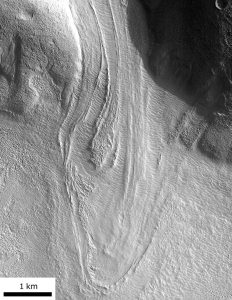
Assistant Professor of Geology Joe Levy and his students are using NASA grant funding and images taken from the Mars Orbiter Mission to study glaciers on the red planet in an effort to further understand how that planet’s climate has changed throughout history. Images provided by the orbiter are of such high resolution that researchers on campus can measure individual boulders and glacier formations right from the comfort of the Robert H.N. Ho Science Center. These “debris-covered glaciers” are creeping rivers of ice covered by a blanket of soil and rock, Levy explains. “A whole debris-covered glacier on Mars is approximately ten kilometers long and one and a half kilometers wide,” he says. “To give you a sense of scale, a glacier’s length is the distance between Hamilton and Earlville.” If you melted down all of the glaciers on Mars, Levy adds, and “spread them out evenly over the surface of the planet, it would be a global layer about one or two meters deep — enough to make a little ocean over all of Mars.”
University gets NSF grants for new lab technology
Dogs are funny. Every other animal lives longer as it increases in size — mice live a year or two at most, while elephants can live for 70. Not so with dogs, whose lifespans decrease as the breeds get larger. “A Chihuahua will live to 16 easily,” says Assistant Professor of Biology Ana Jimenez, “while a Great Dane is old at 6.” Jimenez has been working to unravel this mystery, and she now has access to a powerful new tool to do that: a Seahorse XFe 96 oxygen flux analyzer for integrative organismal and cellular biology.
Colgate University recently acquired that mouthful of a machine through a $271,077 grant from the National Science Foundation (NSF). “It’s our Ferrari on a benchtop,” Jimenez says about the device’s high price tag, before adding: “I’d prefer the Seahorse.” That’s because the state-of-the-art equipment is able to do something no other tool in the lab can do: measure metabolism inside living cells in real time. “Metabolism is the underlying biochemical process that affects everything in the cell,” Jimenez says. “This is a tool that can bring that abstract concept to life.”
The Seahorse is one of two recent additions to Colgate’s equipment that juices up its already formidable capacity to carry on scientific research. “I’m not aware of any other undergraduate institution that has this equipment,” says Associate Professor of Biology Geoff Holm, who is using the Seahorse to investigate metabolism of viruses. “Resources like this are incredibly rare — and it’s even rarer for students to be using it to do research.”
The size of a proverbial breadbox, the Seahorse contains a plate with 96 wells in which a researcher can culture cells for an experiment. The machine can then perform an array of processes to investigate how cells use oxygen and sugars. Jimenez and her undergraduate students have already found some metabolic links to certain diseases that may affect large dogs more than smaller dogs. “Our hope is that we might find some way to alter these metabolic pathways, possibly by altering the composition of dog food, in order to make them live longer,” Jimenez says.
Holm is using the same machine to investigate how viruses alter the metabolism of human cells. “We know viruses use a whole lot of energy, but not much is known about how they alter cells to make that energy available,” he says. He is particularly interested in how viruses affect cancer cells and whether it might be possible to modify a virus to attack tumors by robbing them of oxygen while leaving healthy cells intact.
It’s not just Colgate faculty, however, who are investigating the role of metabolism in disease. Students in assistant biology professor Priscilla Van Wynsberghe’s intermediate genetics class are using the Seahorse to investigate rare genetic diseases using small worms called nematodes. Each team of students chooses a human disease and analyzes its effects in the worms, which they can plop directly inside the wells of the Seahorse to measure its metabolism. “Working in a cell culture may not allow you to understand what is happening in a whole organism,” says Van Wynsberghe.
The fact that students are able to do complex science on such a sophisticated piece of equipment ramps up the level of engagement in her class, Van Wynsberghe says. “I tell them we are going to play with a multi-hundred-thousand-dollar piece of equipment, and you can see how excited and motivated they are,” she says. And by using equipment most undergrads never touch, they are able to ask much more sophisticated questions than the typical student at their level. “It’s fantastic training in critical thinking,” Van Wynsberghe says. “They come out of Colgate already thinking like a grad student.”
One student who has already benefited from using the equipment is Joshua Winward ’18, who has been working with Jimenez on researching the metabolism of dogs, driving with her for two summers to the University of Rochester to perform experiments. “Having a Seahorse on site will drastically reduce the amount of time running experiments as well as allowing us to run experiments more frequently,” he says. “Having this experience has given me an appreciation for just how much you can learn about any given organism at the cell level just by having access to the right equipment.”
Messing around with magnetism
Not only is Colgate adding new, sophisticated lab equipment to its stable, but it is also upgrading the equipment it has with new capabilities. This fall, the chemistry lab received a $345,783 grant from the NSF to improve its nuclear magnetic resonance (NMR) spectrometer, an instrument that uses the same technology as MRI machines to discover the structure of molecules. “When you do chemistry, you don’t know what you’ve made until you run a whole lot of tests on it,” says chemistry professor Ernie Nolen. “It’s not like in the kitchen where you can just taste it. It becomes a puzzle to solve for things you cannot see.”
Common techniques such as mass spectrometry only tell researchers which atoms are present, but not how they are connected — a crucial element in dealing with complex organic molecules where the position of a hydrogen or carbon atom can dramatically affect how the molecule functions. In Nolen’s research designing and constructing molecules of biomedical interest, for instance, he needs to identify a galactose sugar called TN antigen, which differs from glucose by one hydrogen atom pointing in the opposite direction. “It’s a tiny change, but it makes a huge biological difference,” he says.
The NMR consists of a powerful magnet — actually, a ball of energized superconducting wire suspended in liquid helium — that can shift the orientation that a nucleus is spinning on its axis. By detecting these “spin flips,” researchers can construct a 3-D picture of a chemical compound in real time. The new upgrade for the system will dramatically increase its sensitivity, allowing researchers to not only tell how an atom is connected to its immediate neighbor, but also how it relates to other atoms in the compound.
Chemistry professor Rick Geier is also using the device to characterize porphyrinoids, a versatile chemical structure in nature that does everything from binding oxygen in red blood cells and absorbing light in chlorophyll to catalyzing a range of biological reactions. Porphyrinoids can be used in a variety of applications, including harvesting energy in photovoltaic cells to improve solar energy, and destroying cancer cells by transferring energy from light to oxygen molecules. In order to achieve those goals, however, it’s necessary to discover efficient methods to synthesize these compounds — the focus of Geier’s research group. “There is a lot of trial and error in developing practical methods to create these compounds,” says Geier. “We are seeking to uncover general principles that make the trial and error more efficient. The NMR spectrometer is a key tool for quickly determining whether we are making the compounds that we think we are.”
Like the Seahorse, the NMR spectrometer is also heavily used by students in both classrooms and research. Professor Anthony Chianese, uses the device in his organic chemistry lab, allowing more than 200 students per year to analyze samples. “They can immediately identify whether their experiments formed what they expected them to form,” he says.
One of Chianese’s students, Linh Le ’18, is using the equipment to analyze reactions to create intricate catalysts called ruthenium pincer complexes. “As an undergraduate, I feel that it is a privilege to have access to this modern equipment, which is widely used nowadays in both industry and research labs,” says Le, who is applying to PhD programs in chemistry. “Consequently, I am more prepared as I embark on my career.”
By learning experimentally rather than vicariously, students leave Colgate with all of the knowledge they need to perform high-level scientific experiments on their own. “We can do real science,” says Nolen. “We are not just saying ‘here is an example of what you would do when you go to graduate school.’ We are actually doing it here.”
— Michael Blanding


